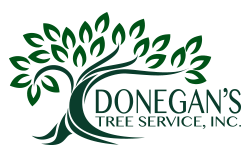How a Wet Spring Impacts Our Trees
As you may have noticed, we have had a very wet spring. According to the US Geological Survey, a station in Lovettsville, Virginia, has recorded 14 inches of precipitation in 2020 already. Due to the heavy rain, there is an increased likelihood of fungal diseases impacting trees in our community. In particular, we are seeing a rise in anthracnose cases, a disease that commonly affects Sycamore and Dogwood trees.
A telling sign of fungal disease on trees is when fewer leaves than usual appear in spring and they’re smaller than what you would normally see. Then, the leaves begin to develop brown spots and wilt, often falling off early in the season. Below are two pictures of Sycamore leaves with anthracnose.
Unfortunately, the effects of the disease tend to become apparent after the leaves have budded out and then it is already too late to effectively treat the fungus. However, after the leaves fall off, you can rake them up and dispose of them properly to remove some of the spores that could overwinter in them. If your trees had a fungal disease this year, it will likely happen again next year, so be sure to contact us in February or March 2021 to meet with our Plant Health Care Specialist, John Ford. He will be able to create a treatment plan for your trees. If left untreated, the tree’s health will begin to decline after a few years, making it more susceptible to other pests and diseases, as well as ill effects from unusual weather patterns.
For more information on anthracnose, please visit:
https://extension.umn.edu/plant-diseases/anthracnose-trees-and-shrubs

